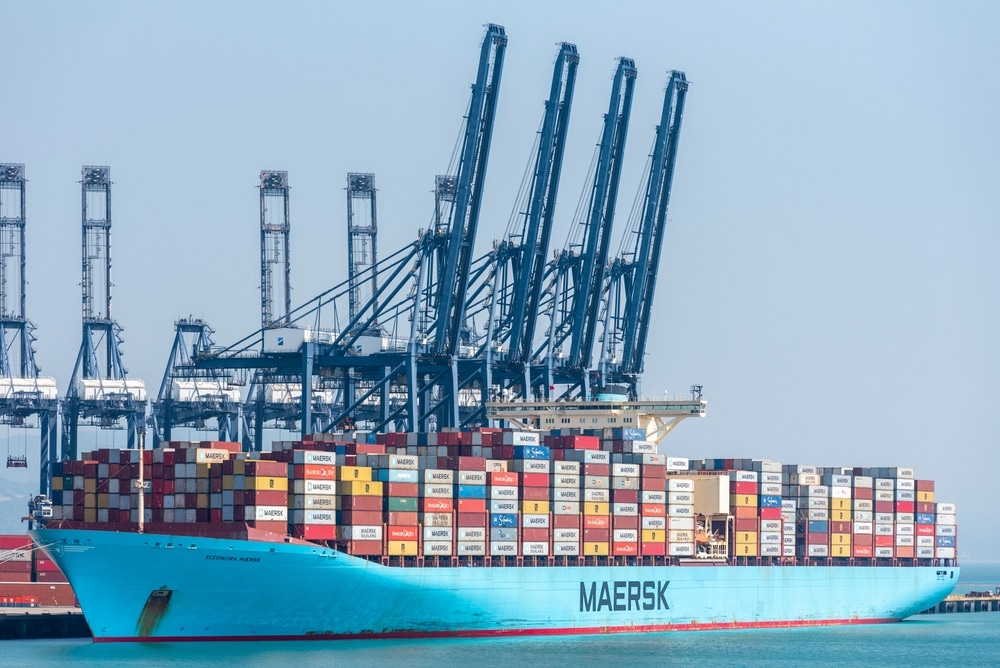Nuclear energy is emerging as a potential game-changer for the maritime shipping industry, which currently relies heavily on fossil fuels. With global shipping responsible for nearly 3% of greenhouse gas emissions, there’s a pressing need to explore cleaner energy alternatives. And the integration of nuclear power into the maritime shipping industry is gaining momentum as a promising solution to achieve zero-emission shipping.
Danish shipping giant Maersk has joined forces with Lloyd’s Register (LR) and UK-based Core Power to explore the potential for nuclear-powered container shipping in Europe. This collaboration represents a significant step in the maritime industry’s efforts to decarbonize.
Teaming Up for Nuclear-Powered Shipping
The study will focus on the feasibility of using a fourth-generation nuclear reactor for powering container ships. Unlike traditional nuclear reactors, these small and mass-produced reactors are designed to consume less nuclear fuel while being less powerful. The partnership will evaluate the necessary regulatory frameworks and safety requirements to operate nuclear-powered vessels in European waters.
Maersk’s head of fleet technology, Ole Graa Jakobsen, acknowledged the challenges associated with nuclear power while also noting that if these challenges can be overcome, nuclear power could become a viable decarbonization option for the logistics industry within the next 10 to 15 years.
Nick Brown, CEO, Lloyd’s Register, remarkably highlighted the role of nuclear in the maritime industry saying that:
“A multi-fuel pathway to decarbonising the maritime industry is crucial to ensuring we as an industry meet the IMO’s emission reduction targets and nuclear propulsion shows signs of playing a key role in this energy transition.”
Core Power’s CEO, Mikal Bøe, echoed Brown’s sentiment noting that “there’s no net zero without nuclear.”
The maritime sector has been increasingly considering nuclear fuel as a potential solution to reduce its carbon footprint. A survey conducted by the International Chamber of Shipping in May 2022 highlighted growing interest in nuclear-powered commercial ships, with some experts predicting their viability within the next decade.
The collaboration between Maersk, LR, and Core Power signals a forward-looking approach to addressing the environmental impact of shipping.
Advanced Nuclear Reactors: The Next Frontier in Maritime Decarbonization
Nuclear power has a long history of use in naval vessels since the 1950s, and its application in commercial maritime shipping is being revisited due to the urgent need for decarbonization. The U.S. is exploring the potential of marinized nuclear reactors to replace aging fleets and meet the International Maritime Organization’s (IMO) target of a 50% reduction in CO2 emissions by 2050.
Among various types of nuclear energy technologies available, SMRs (small modular reactors) are particularly appealing for maritime applications due to their compact size and enhanced safety features.
SMRs are smaller and more flexible than traditional nuclear reactors, making them suitable for installation on ships. SMRs could provide ships with a steady supply of power, enabling them to travel long distances without the need for frequent refueling stops. This could be especially beneficial for large cargo ships and icebreakers operating in remote areas.
MSRs, a type of SMR, offer even greater potential with their ability to operate on various fuel cycles, including thorium, and provide extended refueling intervals.
Countries like the U.S., South Korea, and Denmark are at the forefront of developing these reactors for maritime use. For instance, Denmark’s Seaborg Technologies is working on a compact Gen-IV molten fluoride salt reactor with a 12-year refueling cycle, aiming for deployment on floating power plants.
Why Nuclear Power Could be the Key
One of the most compelling reasons to consider nuclear energy for maritime shipping is its potential to reduce GHG emissions. Nuclear-powered ships do not emit carbon dioxide during operation, unlike conventional ships that burn fossil fuels. More notably, nuclear generates 4x less carbon emission than solar farms.
Additionally, nuclear energy produces minimal waste compared to fossil fuels, and advances in waste management have made it safer and more manageable.
Moreover, nuclear energy offers a high level of energy security and independence for ships. Unlike fossil fuels, which are subject to price fluctuations and geopolitical tensions, nuclear fuel is abundant and can be sourced from multiple countries.
However, while the potential of nuclear-powered ships is significant, there are challenges related to regulatory approval, public perception, and the high initial costs of reactor development. Still, countries like Russia, China, and the U.S. are making strides in overcoming these hurdles.
Russia, for example, already operates nuclear-powered icebreakers and floating power plants, demonstrating the feasibility of nuclear technology in harsh marine environments.
In the U.S., the adoption of nuclear power in maritime shipping could revitalize the domestic fleet, particularly under the Jones Act. The regulation mandates that goods transported between U.S. ports must be carried on U.S.-built and operated ships.
Could Nuclear Power Revolutionize Shipping?
The development of SMRs and advances in nuclear technology are making it increasingly feasible for commercial vessels to be powered by nuclear energy. However, careful consideration of safety, regulatory, and public perception issues will be crucial as the industry moves forward.
In conclusion, nuclear energy presents a promising opportunity for the maritime shipping industry to reduce its environmental impact and increase energy security. While there are still many challenges to overcome, the potential benefits make it an option worth exploring.
With continued research and development, as well as the establishment of appropriate regulatory frameworks, nuclear-powered commercial shipping could become a reality in the coming decades.



